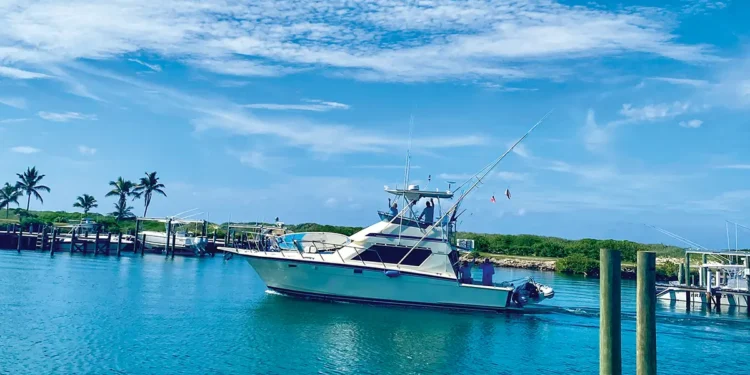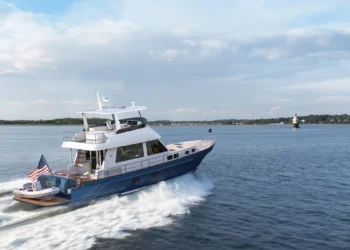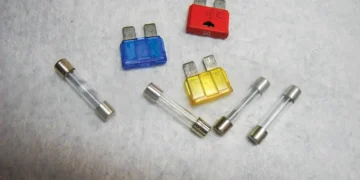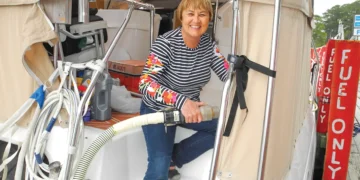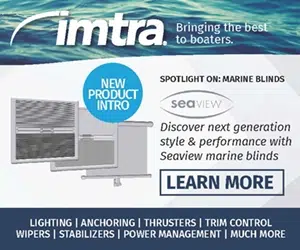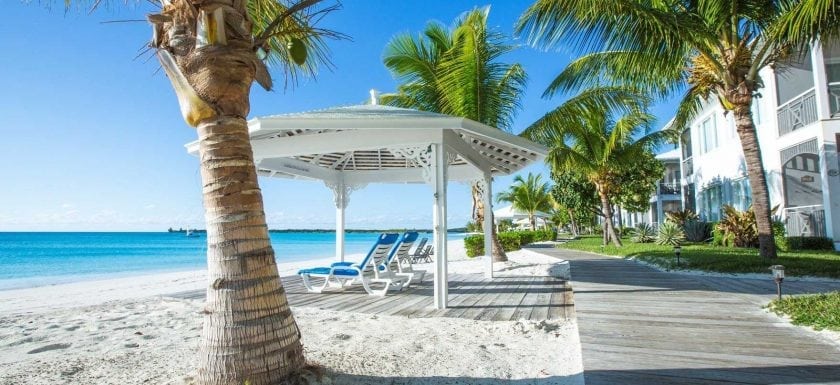One couple’s decision to refit a Hatteras 41-C was well worth the price.
When my husband, Eric Lacey, began the search for a boat we could potentially live aboard, I was completely against it. But then he said these words: “I don’t want to be eighty and wish I had done this when I was able.” What can a loving spouse say to that? So we began the search in earnest, together. After a few years, we found her in a marina in Biloxi, Mississippi. She was a 1987 Hatteras 41-C, with twin 671 Detroit Turbo Inner Cool (TIC) engines. We bought her in February 2022 from the one owner who had “babied” the boat for most of her life. He had given the boat meticulous maintenance and, after interviews with several prospective buyers, allowed us to “adopt” her. Little did we know this passion project would lead to our Hatteras 41-C refit.
First Major Repairs: Hoses, Fluids, and Anchoring
After a successful sea trial, we bought her and took her home to Fairhope, Alabama, mooring her in a slip at Fly Creek Marina. Our mechanic suggested we replace all the high-pressure oil lines, especially those running in and out of the turbos. Our first major task, therefore, was to pull the floors out, get new hoses made, and have our mechanic do an entire hose upgrade, accompanied by complete oil and filter changes for both the engines and the generator (the latter of which is an Onan 8kW). This was a learning experience for my husband, the captain, as he and the mechanic worked together on the entire project. “Particular attention was paid to everything on the outboard side of the engines, which are very difficult to access with the floors installed,” he recalled.
Also Read:
25 New Power Catamarans You’ll Want to Cruise in 2025
Catamarans are stable, roomy, and love to purr. If it seems like there are a lot of new...
Replacing all the hoses and fluids and servicing the engines with material and labor was about $2,000. We saved some money because we had the hoses made, taking the existing hoses to a hydraulic shop and using them as a pattern.
We had a “smoke test” after all this was done, with the mechanic on board. We ran the engines for about an hour and found only one (very minor) oil leak. This was repaired with the application of a wrench.
The next major change was to replace the anchor capstan with a self-tailing anchoring system, a remote-controlled apparatus which included a new anchor and new rode (the line). Just getting the old capstan off was quite a chore. When we finally wrestled the capstan into submission, the shaft came out in rusted pieces—it was completely locked up.
The mechanic fabricated a new stainless steel apron for the updated anchoring system, and with some adjustments, it worked flawlessly. We can now anchor just by pulling the safety pin out before pulling into an anchorage; the rest can be remotely controlled from the flybridge. “This is not only an essential part of our safety gear—it was also a relationship saver,” Lacey joked. That was about $2,500, including hardware and mechanic fee.
Subscribe Here For More Boating Content
We got by with a little help from our … son
The next major effort came when our son Gus was with us on the boat and the starboard engine blew a clamp off the turbo on the exhaust side. This made an enormous mess but also set off fire alarms and, momentarily, we thought we might need the ditch bag. Out came the floors again, and after scrubbing on the underside, it became apparent that the best way to deal with this was to re-paint with white marine paint to cover the smut stains, which had covered everything. We replaced all the clamps on both turbos because of this to prevent it from happening again.
That only cost us (new clamps and hours of labor, including cleaning and painting) about $100. Word to the wise: Replace the clamps on the turbos every 200 hours.
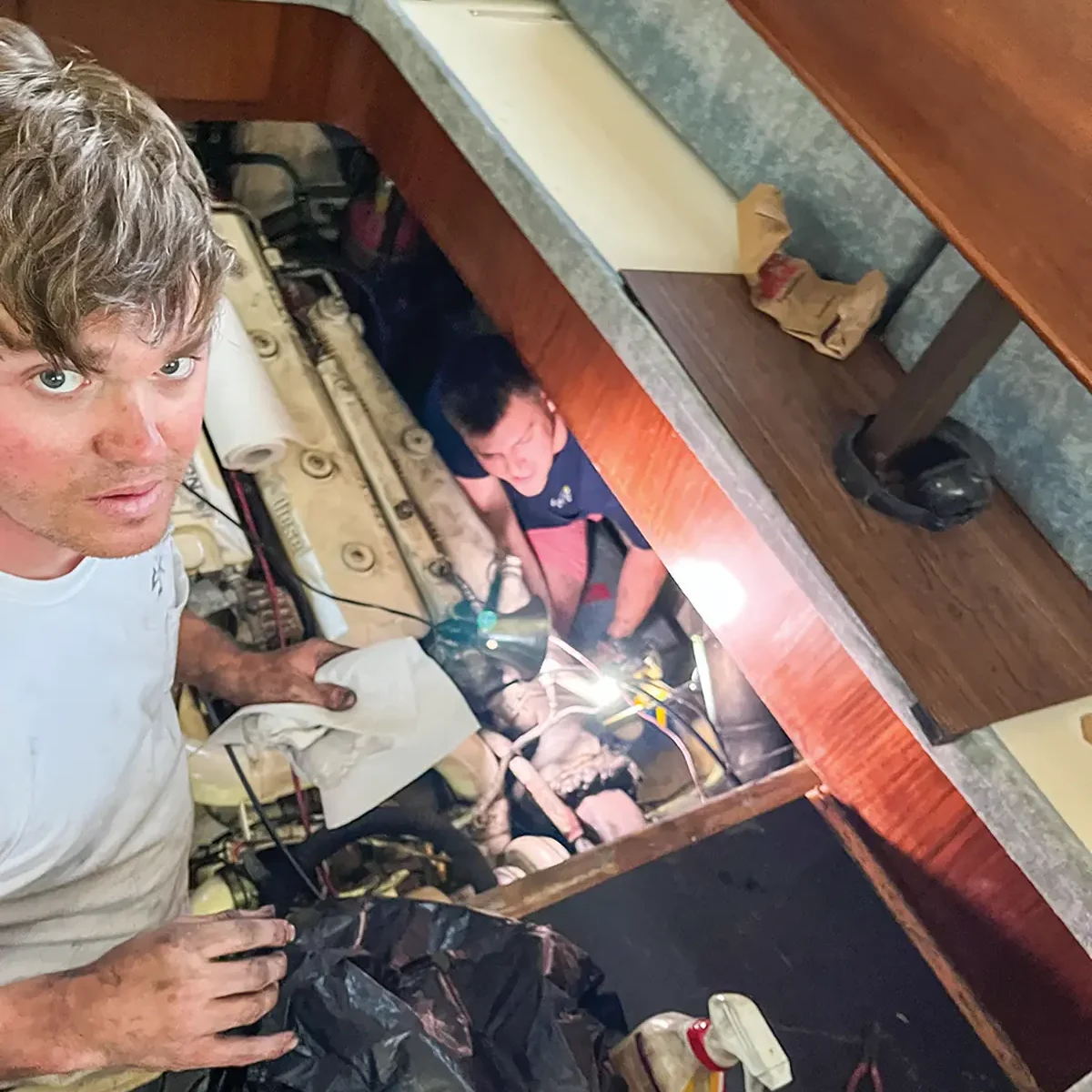
The Electric Part of our Hatteras 41-C Refit
The next project was the solar panels/LiPo batteries/inverter system. The goal was to live off our battery bank and inverters while at anchor, at least overnight. The system was designed by Scott Bickwid in Pompano Beach, Florida, who is a Victron designer/dealer, and came highly recommended by those on the website “Hatteras Forum,” which is sponsored by Sam’s Marine and has an inventory of Hatteras parts that any owner will ever need.
We started with ordering two 330-amp-hour batteries and two Multi-Plus inverter/charger systems, in addition to the two 1,100-watt solar panels, which we installed over the hardtop of the flybridge. That ran through the Cerbo Shunt and into the Multi-Plus control system, and dual Multi-Plus inverter/chargers. This gave us all-night power for the boat, if we didn’t use one of the two air-conditioning units, which allowed us about six hours of comfort. The total cost was around what we would have spent replacing the generator (about $20,000, including equipment, all parts, and labor).
The Multi-Plus system helped us keep our house batteries and lipo-batteries maintained exactly as they should be, and if we lost shore power, it keeps everything else on the boat going. The system is available online so we could remotely monitor it no matter where we were, 24/7. The system is also set up with alerts, which advise us of events, such as a loss of shore power, and tracks power usage and battery status.
Also Read
Meet the Owner-Friendly Hunt Ocean 56: Offshore Poise, Easy Control
For Performance Cruising In An Owner-Friendly Package, Meet Hunt Yachts New Hunt Ocean 56 Hunt Yachts, noted for offshore performance...
The next thing we did was install a Starlink system. Early on, we decided not to mess with the fairly new KVH television/satellite system and opted for Starlink “RV Roam.” The Starlink system came with a motorized antenna, about 100 feet of cable, and a 110 AC router. This system worked flawlessly since installation in 2022.
The Victron and Blink camera systems all work with the Starlink router to communicate with us no matter where we are, so we can work from anywhere. It also provides streaming for the television, Wi-Fi for our computers and telephones, and real-time GPS/Wi-Fi navigation for the Aquamap. The system allows us to work remotely, so we could send and receive emails and even have video conferences while on board. The kit cost $500, with a monthly fee of $165, but we have used it wherever we’ve traveled, with zero issues. “Running the cable down through the hardtop and into the salon was not easy or quick,” Lacey said. “I ended up having to purchase an RJ connector kit and realized there is no space in the wire-chases for anymore accessories.”
As with any boat, bottom jobs and propellers always have issues. With the boat on the northern end of the Gulf Coast, barnacles and green moss are a constant concern. Bottom jobs are required at least once a year. The first year we pulled the boat out, she wasn’t in bad shape, but we pulled the props off and had them match with the spare set, had the bottom cleaned and re-painted, and the hull polished. Because they were not damaged, having both sets of props tuned to the same specifications cost about $1,800. The bottom job, cleaned and polished and painted, cost another $1,800. We also added an underwater light and a full, one-inch additional “throw” on the trim tabs by adding a one-inch block above the tab in-between the tab and the actuator, which gave us the ability to put the bow down a little more to pick up more speed fuel efficiency. While we had her out of the water, we replaced the zincs all around.
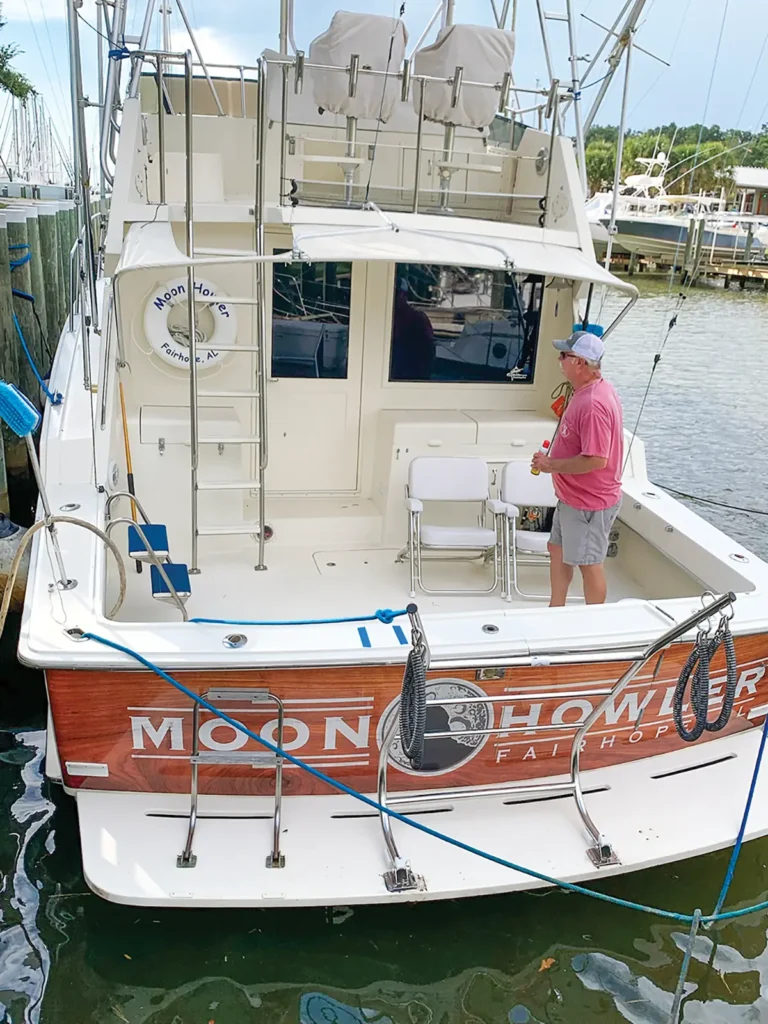
In our local cruises, we tried towing several configurations of skiffs. We wanted to avoid the “rubber duck” dinghy experience and didn’t really explore the davit options. After several long trips, experimenting with tow lines, skiff weight, and just beating and banging, it became apparent we were going to have to go the “rubber ducky” route for a tender. An experienced cruiser friend suggested investigating a “Dinghy Caddy” system, made in Canada. It was suitable for mounting on the swim platform and could handle up to 450 pounds. We coupled it with a 10-foot Highfield dinghy/20-hp Tohatsu combo. It was a great relief to not have a skiff to tow. Total cost (including the trailer for the dinghy) was $8,000.
Just prior to departure in November 2023 (to the Abacos), we noticed an exhaust smell in the engine room. Fearing another messy turbo clamp issue, we pulled the insulating boots off the port turbo and found the exhaust leak; closer inspection found the flanges on the turbo itself were corroded. It could have been catastrophic if not caught and remedied. So, our mechanic came over; we pulled the turbos off, and realized the “wet” exhaust system was the culprit. It was leaking raw sea water back onto the turbo. We are lucky to have Marine Exhaust Systems of Alabama right here in town, so they were able to inspect and estimate the exhaust elbows for reconditioning. Also, we have Test Calibration in Mobile, who were able to get our turbos reflanged and rebuilt in a week. Total for reconditioned wet exhausts (2) and turbos (2) with labor: $6,500. While the exhaust risers were out of the way, we had access to the outboard areas, so we cleaned and painted the engine room and engines.
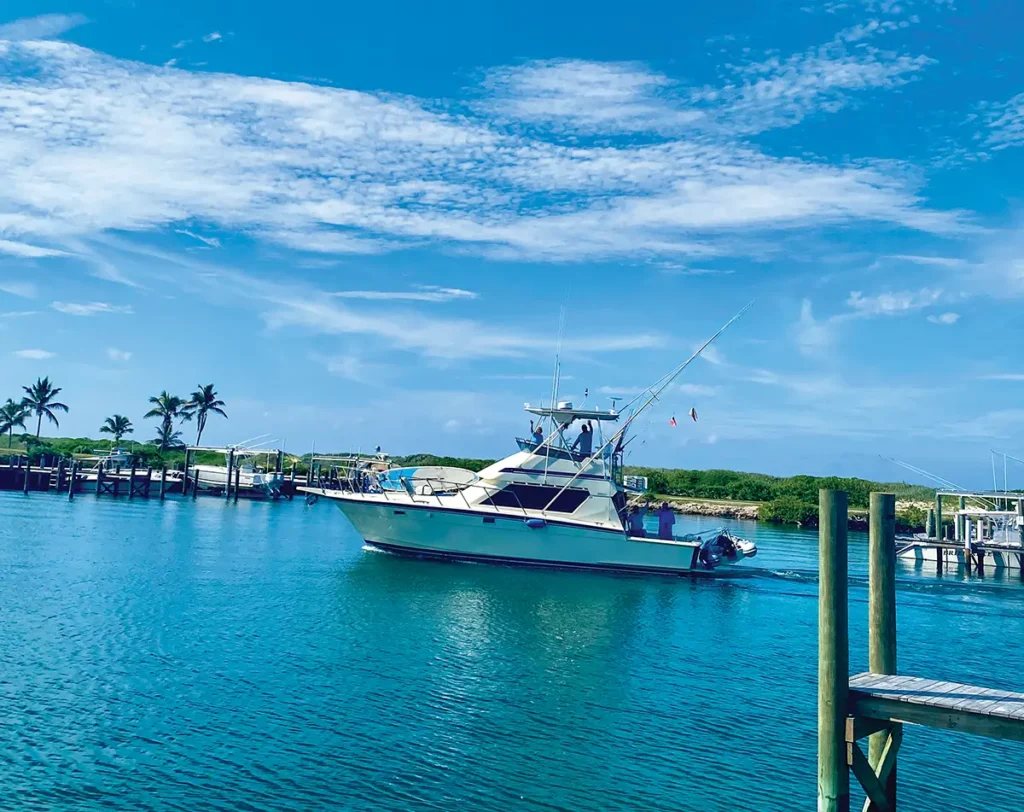
When we purchased the boat, we changed the name to an old family favorite: Moon Howler. It took months to get the paperwork back, and by then, we were heavily involved with the upgrades mentioned above. With several failed attempts at removing the old painted-on lettering and lots of research, we found a company specializing in vinyl wraps. Their advice was for us to lightly sand the lettering—especially paying attention to the edges of the letters—so that the vinyl wrap we chose didn’t have “ridges” where the letters were underneath. In one afternoon, we had a new stern wrap with our name, hailing port, and logo. We don’t know the exact laws we were violating, but having the vessel registered in one name and displaying another was a sure way to attract negative attention if we were ever boarded.
Another “tweak” was our transom door. After installing the davit, the transom door wouldn’t clear and open fully. We love the transom door open when the dinghy’s deployed. The solution was to drive the hinge pins out and have new ones fabricated that we could remove, open the door fully, and replace the pins. The total for this was less than $100, which, for anything on a boat, is a win.
Some people have asked us what, if anything, we regret about buying and refurbishing an older vessel. Our advice is to get a quality vessel with a reputation for being long-lasting and move forward in modernizing it. After we finished bringing Moon Howler to modern-day specs, one of our first trips was to the Abacos, Bahamas. We dropped the hook one night in a crescent-shaped bay on an uninhabited island and slept with the salon door and the hatch both open. The spring breeze and the innumerable stars visible in the dark sky was only topped by the early-morning sounds of dozens of Bahamian Whippoorwills singing nearby. You can’t put a price on an experience like that.
-by T. Jensen Lacey


